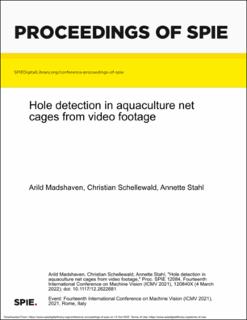| dc.contributor.author | Madshaven, Arild | |
| dc.contributor.author | Schellewald, Christian | |
| dc.contributor.author | Stahl, Annette | |
| dc.date.accessioned | 2022-10-13T11:47:40Z | |
| dc.date.available | 2022-10-13T11:47:40Z | |
| dc.date.created | 2021-11-19T14:59:12Z | |
| dc.date.issued | 2021 | |
| dc.identifier.issn | 0277-786X | |
| dc.identifier.uri | https://hdl.handle.net/11250/3025906 | |
| dc.description.abstract | Frequent inspection of salmon cage integrity is essential to early detect and prevent the possible escape of farmed salmon—minimizing the risk of any negative impact for the remaining wild stock of salmon. Current state-of-the-art computer vision-based approaches can detect net irregularities under “optimal” net and illumination conditions but might fail under real-world conditions. In this paper, we present a novel modularized processing framework based on advanced computer vision and machine learning approaches to effectively detect potential net damages in video recordings from cleaner robots traversing the net cages. The framework includes a deep learning-based approach to segmenting interpretable net structure from background, transfer learning facilitated classification of potential holes from irrelevance, and computer vision-based modules for irregularity detection, filtering, and tracking. Filtering and classification are vital steps to ensure that temporally consistent holes within net structure are reported—and irrelevant objects such as by-passing fish are ignored. We evaluate our approach on representative real-world videos from real cleaning operations and show that the approach can cope with the difficult lighting conditions that are typical for aquaculture environments. | en_US |
| dc.language.iso | eng | en_US |
| dc.publisher | SPIE | en_US |
| dc.title | Hole Detection in Aquaculture Net Cages from Video Footage | en_US |
| dc.type | Peer reviewed | en_US |
| dc.type | Journal article | en_US |
| dc.description.version | publishedVersion | en_US |
| dc.rights.holder | © Society of Photo Optical Instrumentation Engineers. One print or electronic copy may be made for personal use only. Systematic reproduction and distribution, duplication of any material in this paper for a fee or for commercial purposes, or modification of the content of the paper are prohibited. | en_US |
| dc.source.journal | Proceedings of SPIE, the International Society for Optical Engineering | en_US |
| dc.identifier.doi | 10.1117/12.2622681 | |
| dc.identifier.cristin | 1956578 | |
| dc.relation.project | Norges forskningsråd: 282423 | en_US |
| dc.relation.project | Norges forskningsråd: 223254 | en_US |
| cristin.ispublished | false | |
| cristin.fulltext | postprint | |
| cristin.qualitycode | 1 | |
